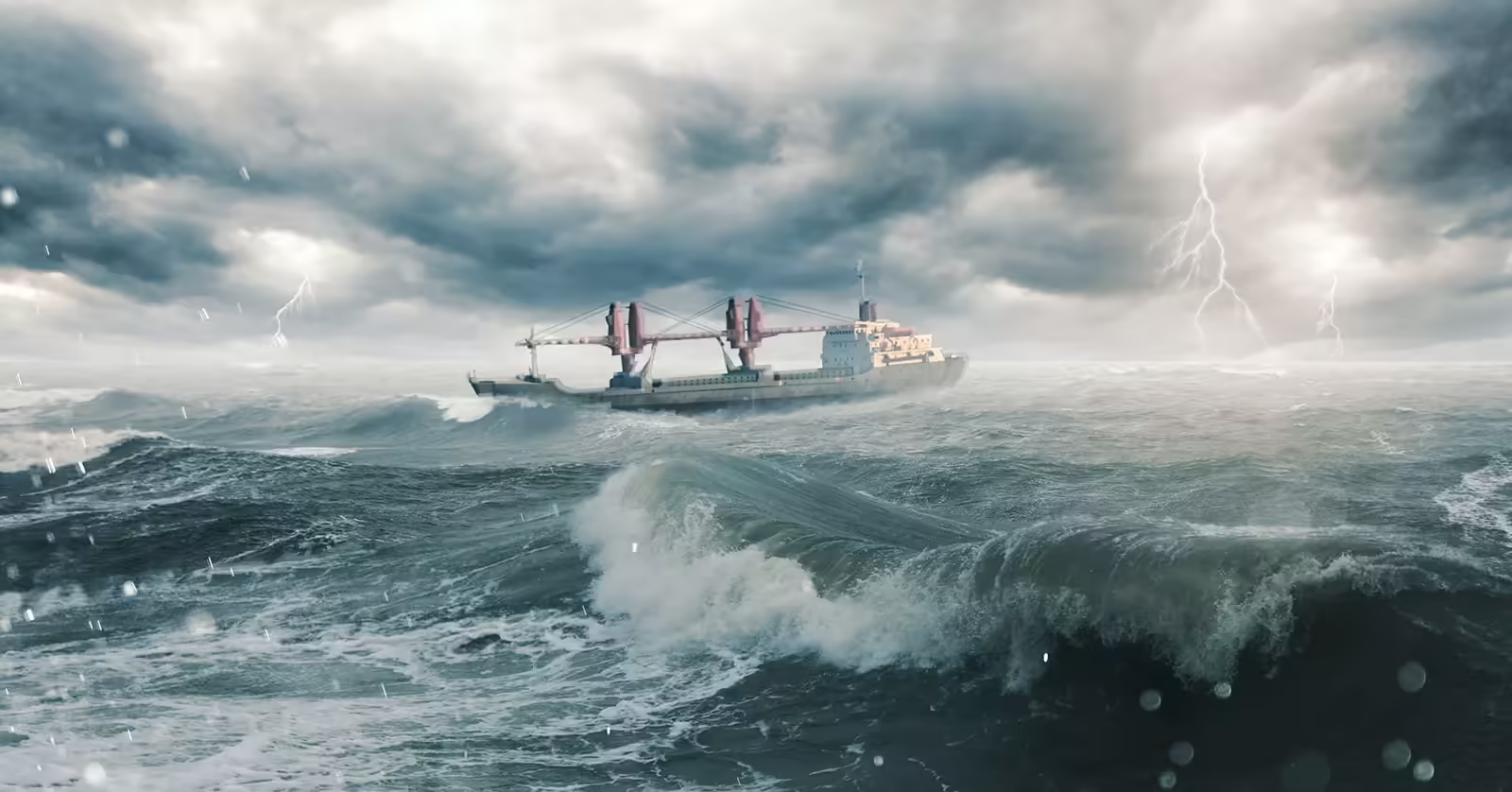Navigating the Jones Act
October 2, 2023

Ever felt like a sailor tossed about in stormy seas? The maritime industry can be just as unpredictable and tumultuous. Imagine you’re on deck when suddenly – ouch! An injury.
Understanding Maritime Laws Related to Injuries and Compensation
The Jones Act, a significant piece of maritime legislation, has far-reaching implications for seamen. This law gives them the right to seek compensation if they’re hurt while performing their duties.
The Jones Act, established in 1920, was formulated to safeguard seafarers. If you’ve been injured at sea, this law protects you.
Rights Under The Jones Act
Getting compensation under the Jones Act isn’t straightforward, though. Generally, to receive maintenance and cure, you must prove that you were injured while working aboard a vessel in navigable waters. Suppose you can show your employer’s negligence led to your injury or that the vessel was not seaworthy. In that case, you can be compensated for lost income, loss of future income, medical expenses, pain and suffering, mental anguish, and other things.
This help can ensure financial worries don’t compound physical injuries after an accident at sea.
Making a claim requires legal expertise, as it involves presenting substantial evidence about safety breaches aboard vessels and establishing causal links between those violations and accidents that lead to personal injuries.
Our attorneys are seasoned in representing injured maritime workers and could effectively guide them through these intricate procedures.
Maintenance and Cure Claims
When you’re hurt while working at sea, there’s a lifeline available to help cover your medical bills and living expenses. It’s called maintenance and cure. What exactly does this term signify?
Maintenance refers to the daily expenses an injured seaman needs during recovery, like food or rent. Cure pertains to the necessary medical costs associated with the injury.
This protection is grounded in maritime law under the Jones Act. Its purpose is to ensure that injured sailors don’t shoulder these burdens alone.
Eligibility for Maintenance and Cure
To qualify for these claims, one must have been employed as a seaman and sustained the injury while on board or in connection with their job.
The amount you are eligible to receive varies from case to case because it depends on actual expenses incurred by the seaman during their healing period. But remember – any doubts about payments are resolved in favor of providing more help rather than less.
If employers fail to pay up when they should’ve done so promptly after an accident, they can also face punitive damages. A jury in a case awarded one of our clients $1.5 million in punitive damages due to his employer’s unreasonable, willful, and wanton failure to provide maintenance and cure to our client.
Remember – if you’re struggling to understand how this applies to your situation – contact us.
Unseaworthiness Claims
If you’re a seaman who’s been hurt, the concept of an unseaworthiness claim might be your lifesaver. These claims stem from the maritime principle that ship owners must maintain their vessels safely for crew members.
When a vessel isn’t up to snuff, it puts everyone on board at risk. If this lack of safety has led to your injury, you may have grounds for an unseaworthiness claim under maritime law. It doesn’t matter if the owner knew about the unsafe conditions; they are still liable.
You might wonder what constitutes “unseaworthy”. It’s broader than just faulty equipment or structural issues with the boat itself – even an ill-trained crew can make a vessel unfit for its intended purpose and, therefore, “unseaworthy”.
Evidence is crucial to starting such a claim. You need proof that links your injuries directly to unsafe conditions aboard the ship. A simple trip-and-fall due to untied ropes could be enough.
A successful unseaworthiness claim can also get you compensation beyond medical bills: lost wages, pain and suffering, and even future earnings are all fair game.
Basic Things Employers can do to keep you Safe
Every sailor knows the saying, “Safety first.” However, implementing safety measures aboard vessels is not as simple as uttering a catchy phrase.
Safety at sea is paramount, and strict measures are in place to ensure the well-being of seamen aboard vessels. These measures aim to prevent accidents, minimize risks, and create a safe working environment. Here’s an overview of essential safety measures that must be in place before seamen can work aboard a vessel:
Training and Certification:
- Basic Safety Training: Every seaman must undergo basic safety training, which includes fire prevention and firefighting, personal survival techniques, personal safety and social responsibility, and elementary first aid.
- Specialized Training: Depending on their role, seamen may need additional training in advanced firefighting, medical care, or handling hazardous materials.
Safety Equipment:
- Life-saving Appliances: This includes lifeboats, life rafts, life jackets, and immersion suits.
- Firefighting Equipment: Fire extinguishers, fire hoses, sprinkler systems, and firefighting suits should be readily available.
- Safety Signage: Clear signs indicating emergency exits, muster stations, and safety equipment locations.
Regular Drills:
- Fire Drills: Regular fire drills should ensure crew members are familiar with evacuation procedures.
- Abandon Ship Drills: Crew members should practice using life-saving appliances and know how to abandon ship safely.
- Man Overboard Drills: Procedures for retrieving someone who has fallen overboard should be practiced routinely.
Safety Protocols and Procedures:
- Safety Management System (SMS): Vessels should have an SMS outlining the policies, responsibilities, and procedures for safety and pollution prevention.
- Risk Assessments: Before any task, potential hazards should be identified, and measures should be implemented to mitigate them.
- Reporting System: A clear system for reporting hazards, near misses, and incidents should be established.
Vessel Maintenance:
- Regular Inspections: Vessels should undergo frequent inspections to ensure they are in good condition and free from defects.
- Maintenance Log: A record of all maintenance activities, repairs, and inspections should be maintained.
Safety Gear for Crew:
- Personal Protective Equipment (PPE): Depending on their tasks, crew members might need helmets, gloves, safety boots, eye protection, and hearing protection.
- Harnesses and Safety Lines: For those working at heights or in areas with a risk of falling overboard.
Communication Systems:
- Emergency Communication: Systems like the Global Maritime Distress and Safety System (GMDSS) should be in place for distress signaling and communication.
- Internal Communication: Crew members should have a means to communicate internally, especially in emergencies.
Health and Hygiene:
- Medical Facilities: Every vessel should have a designated area with essential medicines, equipment, and a trained medical officer.
- Hygiene Standards: Proper sanitation, clean drinking water, and waste management systems should be in place.
Security Measures:
- Access Control: Unauthorized persons should not be allowed on board, and there should be a system for tracking all personnel on the vessel.
- Security Drills: Crew members should be trained to respond to potential security threats like piracy.
Safety Culture:
- Safety Meetings: Regular safety meetings should discuss potential risks, share safety information, and reinforce safety culture.
- Continuous Improvement: Crew members’ feedback should be taken seriously, and efforts should be made to continuously improve safety measures.
Navigational Safety
Navigational safety is essential for preventing maritime accidents, such as collisions, groundings, and strandings. Depending on the vessel’s type, size, and purpose, there are several navigational safety systems and equipment that vessels are required to implement and maintain. Here’s an overview of the key navigational safety systems that are commonly implemented on vessels:
Electronic Chart Display and Information System (ECDIS):
- A computer-based navigation system that displays electronic navigational charts (ENCs) and integrates various navigational sensors to continuously show the ship’s position.
Radar Systems:
- Used to detect and track other vessels and obstacles, even in poor visibility conditions.
- Modern radar systems come with Automatic Radar Plotting Aids (ARPA) capabilities, automatically tracking targets and predicting their positions.
Automatic Identification System (AIS):
- Transmits the ship’s information (such as identity, position, course, and speed) to nearby ships and coastal authorities.
- Helps in collision avoidance by displaying information about nearby vessels.
Global Positioning System (GPS):
- Provides accurate position information, helping mariners to navigate safely.
- Many ships use Differential GPS (DGPS) for enhanced position accuracy.
Gyrocompass and Magnetic Compass:
- The gyrocompass provides accurate heading information based on the earth’s rotation.
- A magnetic compass serves as a backup and is also used to check the gyrocompass’s accuracy.
Echo Sounder (or Depth Sounder):
- Measures the depth of water beneath the ship’s keel.
- Helps in avoiding shallow areas and ensuring the vessel is in safe waters.
Navtex Receiver:
- Receives meteorological warnings, navigational warnings, and other urgent maritime safety information.
Speed Log:
- Measures and displays the ship’s speed over the ground or through the water.
Bridge Navigational Watch Alarm System (BNWAS):
- Monitors bridge activity and detects the officer on watch’s awareness.
- Sounds an alarm if the officer on watch becomes incapacitated, ensuring continuous monitoring of the bridge.
Voyage Data Recorder (VDR):
- Often referred to as the “black box” of ships, it records data related to the ship’s operation.
- VDR data can be analyzed in case of an accident to determine the causes.
Emergency Position Indicating Radio Beacon (EPIRB):
- Activated in emergencies, it transmits the ship’s position to search and rescue services.
- Modern EPIRBs are typically integrated with GPS for accurate positioning.
Search and Rescue Transponder (SART):
- It responds to a radar signal in lifeboats and life rafts, helping rescuers locate the survival craft.
Integrated Bridge Systems (IBS):
- Integrates various bridge systems and equipment to provide centralized access and control.
- Enhances situational awareness and decision-making during navigation.
Pilotage:
- A local pilot is mandatory in certain waters, especially busy ports or areas with navigational hazards.
- The pilot has expert knowledge of the area and assists the ship’s captain in navigation.
Fire Prevention and Control Systems
Vessel fires can cause significant harm to both crew members and the ship itself. Thus, ships need fire detection sensors, alarm systems, extinguishers, sprinklers, and firefighting suits. It’s also vital to hold regular drills so everyone knows how to respond if there’s a fire.
Fire Detection and Alarm Systems:
- Smoke Detectors: Installed in accommodation areas, engine rooms, and other spaces to detect smoke.
- Heat Detectors: Used in areas where smoke detectors might not be effective, such as galleys or boiler rooms.
- Fire Alarm Panels: Centralized systems that indicate the zone of fire detection and activate auditory and visual alarms.
Firefighting Equipment:
- Fire Extinguishers: Different types (e.g., CO2, dry powder, foam, water) are placed strategically throughout the ship.
- Fire Hoses and Hydrants: Located at various decks and compartments for immediate access.
- Fireman’s Outfit: Protective clothing, including a helmet, boots, gloves, and a breathing apparatus for firefighters.
Fixed Fire Suppression Systems:
- CO2 Flooding System: Used primarily in engine rooms, this system releases carbon dioxide to smother fires by reducing oxygen levels.
- Water Sprinkler and Drencher Systems: Installed in accommodation areas to control and extinguish fires.
- Foam Systems: Used for flammable liquid fires, foam systems smother the fire and prevent re-ignition.
- Clean Agent Systems: Deploy non-conductive, vaporizing agents with no residue, which is ideal for spaces with sensitive equipment.
Water Mist Systems:
- Uses fine water droplets to cool the environment, displace oxygen, and suppress the fire.
Fire Doors and Bulkheads:
- Automatic and manual fire doors prevent the spread of fire between compartments.
- Fire-resistant bulkheads further compartmentalize the ship and act as barriers to fire spread.
Ventilation Shutdown System:
- Allows for the immediate shutdown of ventilation systems to prevent the spread of smoke and fire.
Emergency Escape Routes:
- Marked and easily accessible routes ensure crew members can quickly evacuate in case of a fire.
Fire Control Plan:
- A detailed plan was displayed on the ship, showing the location of all firefighting equipment, escape routes, and the general layout of the vessel.
Fire Drills and Training:
- Regular fire drills ensure the crew knows their roles during a fire emergency.
- Training on using firefighting equipment is mandatory for all crew members.
Emergency Fire Pumps:
- Standby pumps that ensure the availability of water for firefighting even if the main pumps fail.
Fire Dampers:
- Installed in ventilation ducts, they prevent the spread of fire and smoke through the ventilation system.
Inert Gas Systems (IGS):
- Used primarily on oil tankers, IGS fills cargo tanks with inert gas, reducing the oxygen content to prevent explosions.
Insulation:
- Materials used in the vessel’s construction, such as insulation for pipes and bulkheads, should be fire-resistant.
Regular Inspections and Maintenance:
- Routine checks of all firefighting equipment to ensure they are in good working condition.
- Maintenance and servicing as per international standards and regulations.
Fall Protection Measures
Falls from height are one common injury source aboard vessels. Vessel owners are responsible for minimizing the risks associated with falls, both overboard and within the ship. Here are some measures vessel owners are typically required to implement to prevent falls:
Guardrails and Handrails:
- Install and maintain guardrails around the ship’s perimeter, especially near the deck edges.
- Handrails should be provided in stairways, ladders, and other areas with a risk of falling.
Safety Nets:
- Safety nets can be installed to catch anyone who might fall in areas where guardrails might not be feasible.
Anti-Slip Measures:
- Use non-slip paint or coatings on deck surfaces.
- Install anti-slip mats in frequently wet or slippery areas, like the galley or around entranceways.
Proper Lighting:
- Ensure that all areas of the ship, especially walkways and work areas, are adequately illuminated.
- Repair or replace any malfunctioning lights promptly.
Secure Openings:
- Manholes, hatch openings, and other openings on the deck should be securely covered or barricaded when not in use.
- Clear signage should indicate any open hatches or potentially hazardous areas.
Safety Gear:
- Provide crew members with appropriate safety gear, such as harnesses and safety lines, especially when working at heights or in conditions where there’s a risk of falling overboard.
Regular Inspections:
- Conduct routine inspections to identify and rectify potential fall hazards. This can include loose railings, corroded equipment, or worn-out non-slip surfaces.
Training:
- Regularly train the crew on safety procedures and the importance of using safety equipment.
- Conduct drills simulating man-overboard situations to ensure the crew is prepared to respond effectively.
Housekeeping:
- Ensure that decks, walkways, and working areas are free from obstructions and hazards.
- Clean up any spills immediately to prevent slipping.
Safe Work Practices:
- Implement and enforce safe work practices, especially for tasks that involve working at heights or near open deck edges.
- Ensure crew members use safety harnesses and other protective equipment when required.
Signage and Markings:
- Use clear signage to indicate areas with potential fall risks, such as steep staircases or uneven deck areas.
- Mark the edges of stairs, steps, and thresholds with high-visibility paint or tape.
Ladder Safety:
- Ensure ladders are in good condition, with non-slip rungs and stable footing.
- Train crew members on safe ladder usage.
Safety Procedures for Adverse Weather:
- Implement procedures for adverse weather conditions, such as restricting access to certain areas during heavy seas or storms.
Feedback System:
- Encourage crew members to report any observed hazards or unsafe practices, allowing for continuous improvement in safety measures.
Type Of Injuries Incurred
The vast expanse of the ocean offers breathtaking views and endless horizons, but for the seamen who navigate its waters, the marine environment also presents unique challenges and dangers. Working aboard a vessel is unlike any land-based job. The confined spaces, the ship’s constant motion, exposure to the elements, and the operational demands of marine vessels contribute to a range of potential hazards. Understanding the types of injuries seafarers might sustain is crucial for prevention, timely intervention, and ensuring the overall safety of everyone on board. Below are some common injuries:
- Slip, Trip, and Fall Injuries: These are among the most common injuries on ships. Wet and slippery decks, obstructions, unsecured equipment, or rough seas can lead to falls that result in sprains, fractures, head injuries, and even fatalities.
- Crush Injuries: Heavy machinery, moving equipment, and shifting cargo can pose risks. Seamen can get caught between objects or machinery, leading to crushed limbs, broken bones, or severe internal injuries.
- Burn Injuries: Exposure to steam, hot surfaces, fires, or chemicals can cause burns. Depending on the severity, burns might require extensive medical treatment and can lead to permanent scarring or disability.
- Chemical Exposure: Handling or being exposed to hazardous materials and chemicals can lead to skin irritations, respiratory problems, or poisoning.
- Overexertion and Strain Injuries: Repeated heavy lifting, pushing, or pulling can lead to muscle strains, hernias, and back injuries.
- Drowning and Near-Drowning Incidents: Falls overboard, especially in rough seas or without the immediate notice of other crew members, can result in drowning. Near-drowning incidents can lead to complications like hypothermia or lung injuries.
- Electrical Injuries: Faulty wiring, exposed electrical components, or mishandling of electrical equipment can lead to shocks, burns, or electrocution.
- Hearing Loss: Chronic exposure to loud machinery and engine noise without proper ear protection can lead to temporary or permanent hearing loss.
- Respiratory Injuries: Inhaling toxic fumes, smoke from fires, or poorly ventilated areas can cause respiratory issues, including lung damage.
- Lacerations and Abrasions: Sharp objects, broken equipment, or machinery can cause cuts and wounds. Without proper care, these can lead to infections or complications.
- Exposure to Extreme Temperatures: Working in extreme cold or heat without proper protective clothing can lead to hypothermia or heat-related illnesses.
- Confined Space Injuries: Working in tight or enclosed spaces without proper ventilation can lead to a lack of oxygen, exposure to toxic gases, and other hazards.
- Eye Injuries: Exposure to bright lights, flying debris, chemicals, or not using protective eyewear can lead to eye injuries, which can impair vision.
The Role of Legal Help
No doubt about it—these claims aren’t DIY projects. Navigating legal waters requires experienced help—an attorney well-versed in maritime injury law. They can guide you through the process, ensuring your claim is as watertight as possible.
With Morrow & Sheppard at your side, you’re not alone. Help is available to ensure justice sails smoothly towards you. Hurt doesn’t have to mean helpless, not with Morrow & Sheppard by your side!
Securing your rights and receiving due compensation isn’t just about recovering from the physical aftermath and reclaiming peace of mind and stability. Our experienced Jones Act lawyers at Morrow & Sheppard are deeply familiar with the intricacies of maritime law and the unique challenges injured seamen face. With a track record of advocacy and results, our dedicated team stands ready to guide you through the legal process, ensuring you receive the justice and compensation you deserve. Don’t navigate these turbulent waters alone; let Morrow & Sheppard be your beacon of hope and assistance. Contact us today for a free, confidential consultation.
Daniel Sheppard is licensed to practice personal injury law in Texas and Louisiana. Daniel takes pride in providing exceptional service to clients who were seriously hurt on the job and brings his relentless work ethic into the office and the courtroom. Learn more about Daniel.
- Home
- |
- Maritime Injuries
- |
- Navigating the Jones Act

















































